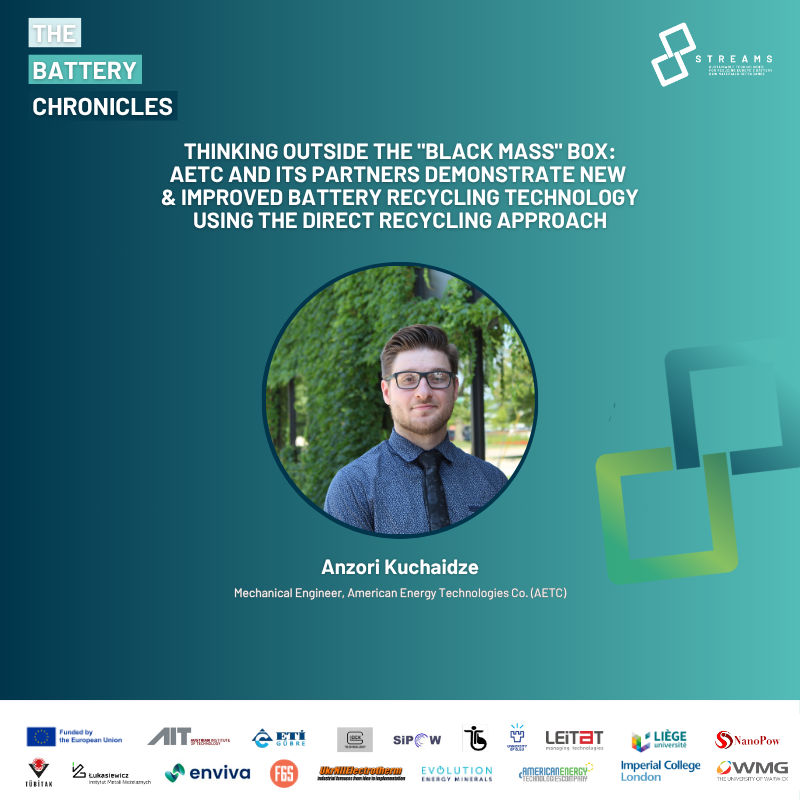My name is Anzori Kuchaidze, and I’m one of the Mechanical Engineers, as well as an Inside Sales Representative at the American Energy Technologies Co. (AETC) of Wheeling, IL, USA. AETC’s unique approach to the energy concerns of our time resulted in our collaboration with three major international energy projects falling under the umbrella of Horizon Europe Program: STREAMS, SAFELOOP and GR4FITE3. These projects bring together over a two dozen of organizations that are collaborating to move Europe into developing and strengthening its own supply chain for battery production and recycling. Although separate entities with unique goals, there was enough green-focused overlap between them that AETC fit perfectly into the picture.
One of the tasks that we routinely handle under projects STREAMS and SAFELOOP is recycling of spent lithium-ion batteries, something that those who are familiar with the field will know is not done very efficiently or thoroughly. The end result of the classic recycling process, known as “Black Mass” technology is typically the downcycling of recycled materials, heavy usage of acids, copious amounts of water in hydrometallurgical processing and generation of waste of other components outside the holy grail of rare earth metals. Working together with other engineers, chemists and specialists in the field, we were able to develop, construct and are now recycling at scale three unique lithium battery chemistries. STREAMS provided us with Nickel Cobalt Aluminum Oxide or NCA batteries, along with Lithium Iron Phosphate, or LFP batteries, while SAFELOOP provided us with Nickel Manganese Cobalt or NMC batteries. Spent cells come into the program from an EV battery manufacturer Wamtechnik Sp.o.o. of Piaseczno, Poland and from ASPILSAN ENERJI SANAYI VE TICARET AS, a European GigaFactory, located in Kayseri, Turkey.
Amongst all three chemistries we focus on recycling and reuse of every component of the battery. The metal casing that protects the battery’s electrode roll is separated and prepared for metal recycling. The electrode roll is separated into anode, separator and cathode, with each component uniquely transformed into a purified and uniform state.
The anodes are a particular point of interest for AETC, as we are graphite specialists. Our unique understanding of the material and familiarity with its handling at our newly built industrial graphite and carbon processing plant located in Wheeling, Illinois, USA allows us to collect the graphite, purify it of any contaminants, and reshape it into “repaired” graphite. This repaired graphite can be used in a wide variety of energy technologies, newly made batteries being only but one of them. The separators are transformed into an additive that electrically enhances the properties of all battery chemistries, mainly on the cathode side. The cathode actives are processed in a novel manner that result in collection of rare earth metals salts – something which our European partners at Oulun Yliopisto, Oulu, Finland, University of Warwick, Coventry, Great Britain, Instytut Sorbtsiyi Ta Problem Endoekolohiyi Natsionalnoyi Akademiyi Nauk Ukrayiny, Kyiv, Ukraine, and GREENMAT CESAM Research Unit at Liege University, Liège, Belgium are taking from us to upgrade into newly made NCA, LFP and NMC. The extracted cathode materials are sent to partners at STREAMS for further analysis, who were quite satisfied with the results.
After maturing the recycling technology at the bench scale, we paired up with a fellow STREAMS Partner: The Ukrainian Research and Design Institute of Electrothermal Equipment (UNE) of Zaporizhzhya, Ukraine. Together, we collaborate to scale up the battery recycling process to the full-scale plant level, while also addressing and efficiently resolving our bottlenecks at the pilot plant scale. Their assistance allowed us to increase our pilot plant capacity, giving us insight into developing the larger production-scale facility. I had the opportunity to manage our meetings together between AETC and UNE, set objectives, and correct courses. Our weekly meetings created a dynamic and growing evolution of our technologies that will continue into the future.
I have been with AETC since 2022 and have seen firsthand how our growing involvement with partners both domestic and international in their energy initiatives has shaped the world for a greener and brighter future. Our clients and partners yield an invaluable understanding of the energy world because of our services and products, and we only grow in our capabilities and expertise as we branch out. I and the others at AETC look forward to our continued partnership with STREAMS and SAFELOOP, and future new partners as well. Let’s walk together into a greener future!
Contact us, at American Energy Technologies Company, if you desire to become part of the EU or a North American supply chain in graphite and battery recycling. For more information, visit: www.usaenergytech.com.
You can download the full article here.

